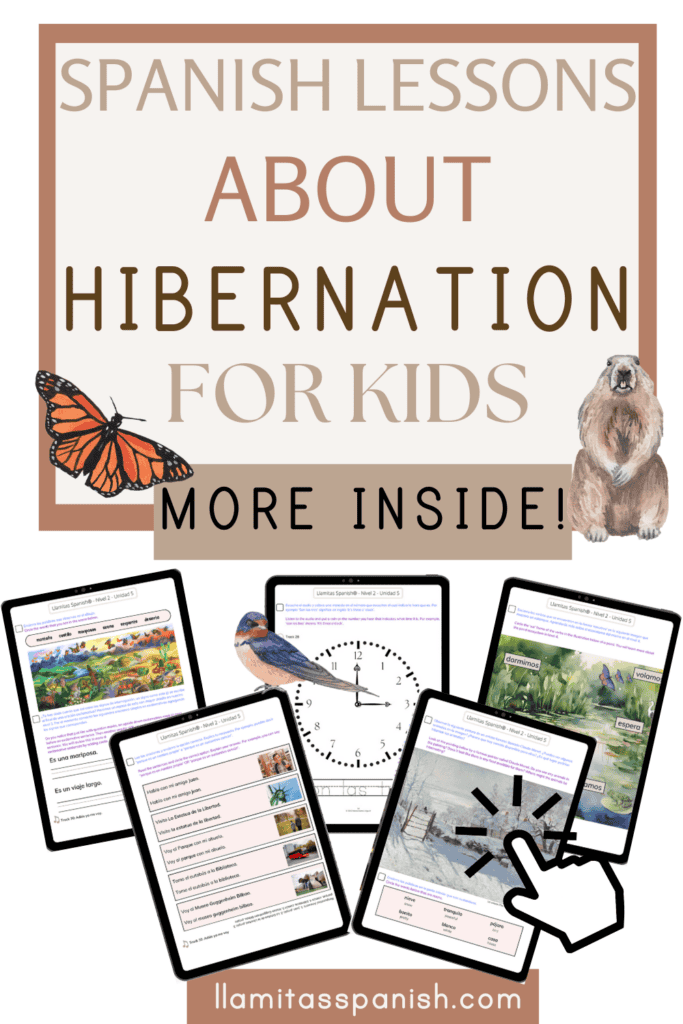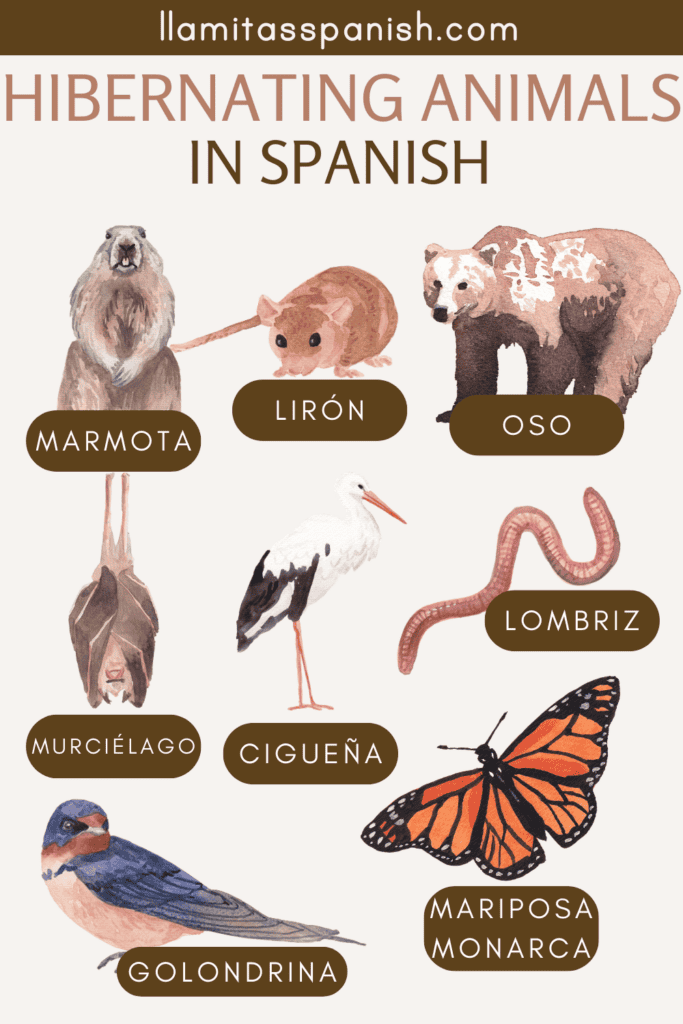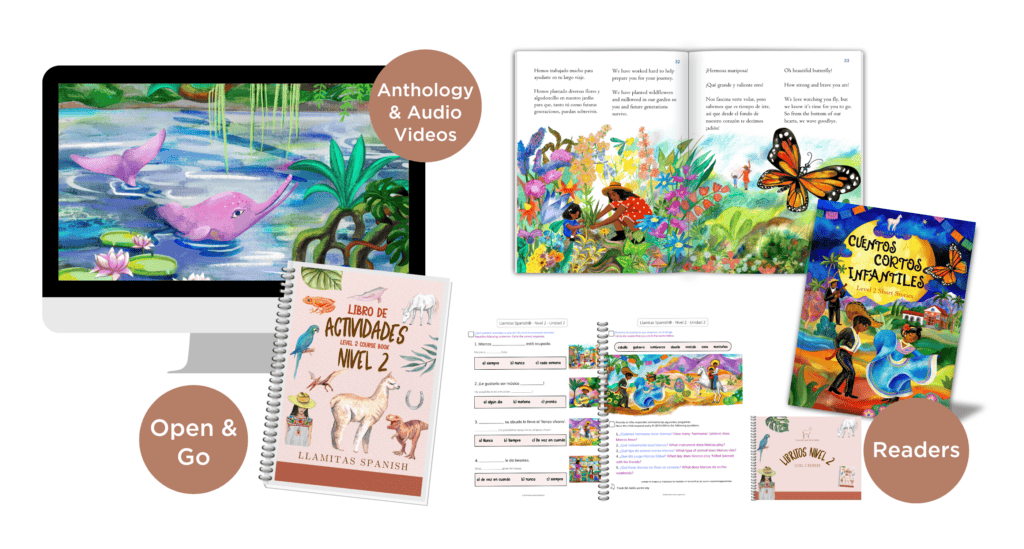In this post: We provide you with resources to explore the fascinating topic of hibernation in your Spanish lessons. Plus, learn about our hibernation unit in our new Level 2 curriculum!
Kids are naturally curious about the world around them—they’re like little scientists. As the seasons change, it’s not unusual for young children to observe and notice that they see more or less of certain animals in their yard and start asking questions, like “Where do the bees go in winter?”
Hibernation is a wonderful topic for children to learn about in the elementary level, and we’ve dedicated an entire unit to this subject in our Level 2 curriculum.

At Llamitas Spanish, we teach kids Spanish through cross-curricula thematic units that include cultural studies, geography, sciences, and more. Structuring lessons around themes is so beneficial for language learning, because kids can apply their new skills to subjects that interest them.
They’ll love learning all about what the animals are up to during the cold winter months with Spanish lessons about hibernation!
Table of Contents
How do you say hibernation in Spanish?
The word “hibernation” in Spanish is la hibernación (lah ee-behr-nah-syohn).
There are a couple of things to note here. First, remember that the letter ‘H’ is silent in Spanish. Just like, for example, you don’t pronounce the ‘H’ in “hola.” We teach beginner students this in our Level 1 curriculum.
You’ll also notice that la hibernación is a feminine noun, which is why we use “la” instead of “el.”
Here are a couple of examples of la hibernación in a sentence:
- El oso está despertando de la hibernación. (The bear is waking up from hibernation.)
- Las ardillas listadas entran en hibernación durante el invierno. (Chipmunks go into hibernation during the winter.)
Related post: Spanish Winter Unit Study for Kids
What is hibernation?
Hibernation is a state that some animals go into to survive the cold winters. We often simplify the concept of hibernation by saying the animals are simply sleeping for a long period of time. But there’s a little more to it than this.
In our hibernation unit, we teach that: “La hibernación es un estado de actividad metabólica reducida” Translated into English, that means that hibernation is a state of reduced metabolic activity.
Basically, hibernation is a way that animals conserve their energy so they can survive through adverse weather conditions or a lack of food during the colder months. But it isn’t just sleeping. Actually, the animal’s body temperature and heart rate are reduced, slowing down their metabolism drastically.
Depending on the species of animal, hibernation can last from days to months. Some animals go into a very deep “sleep,” like many rodents, while others go into a lighter “sleep” and can wake easily, like bears.
Related post: El bosque: Forest-themed Spanish lessons
Hibernating Animals in Spanish
We often hear about bears hibernating for the winter, but there are so many more animals that also hibernate!

Here are just some of the hibernating animals you can learn in Spanish:
| Spanish | English | Pronunciation |
| abejorro | bumblebee | ah-beh-hoh-rroh |
| ardilla | squirrel | ahr-dee-yah |
| ardilla listada | chipmunk | ahr-dee-yah lees-tah-dah |
| cigueña | stork | see-gweh-nyah |
| colibrí | hummingbird | koh-lee-bree |
| geco | gecko | heh-koh |
| golondrina | swallow | goh-lohn-dree-nah |
| lagarto | lizard | lah-gahr-toh |
| lirón | dormouse | lee-rohn |
| lombriz | worm | lohm-brees |
| mapache | raccoon | mah-pah-cheh |
| marmota | groundhog | mahr-moh-tah |
| mofeta | skunk | moh-feh-tah |
| murciélago | bat | moor-syeh-lah-goh |
| oso | bear | oh-soh |
| rana | frog | rrah-nah |
In our unit on hibernation, students will also learn concepts such as the lifecycle of a frog, proper nouns vs. common nouns, and telling the time on the hour. Plus, they’ll read a beautiful story about the migrating Monarch butterfly!
Marmota Song
At Llamitas Spanish, we believe in the power of music for language learning, and incorporate nursery rhymes and songs into our lessons often.
In fact, research shows a clear relationship between music and language acquisition. From the rhythm and repetition to the imagery and emotions it can evoke, it’s no wonder music can build such strong connections in our brains.
Of course, we keep this in mind when creating our own Spanish songs for kids, like our original Marmota Song that we’ve included in our Level 2 curriculum.
The marmota (groundhog) is another hibernating animal and the focus of this fun and easy song, though it’s full of other animal and nature Spanish vocabulary.
Here are the lyrics:
| Spanish Lyrics | English Translation |
| La marmota, la marmota Sale ya, sale ya de su madriguera, de su madriguera ¡Miralá! ¡Miralá! En el piso, en el piso su sombra no se ve, su sombra no se ve. Eso nos indica que ya es primavera ¡Tra la lá!, ¡Tra la lá! En la primavera, en la primavera el pájaro canta y come una lombriz. El conejo salta, la mariposa vuela muy feliz, muy feliz. | The groundhog, the groundhog Comes out now, comes out now from his den, from his den Look at it! Look at it! On the ground, on the ground It doesn’t see its shadow, it doesn’t see its shadow. That means that it’s springtime Tra la la! Tra la la! At springtime, at springtime The bird sings and eats a worm. The bunny jumps, the butterfly flies very happily, very happily. |
Take a listen together—you and your kids will be singing along in no time!
Spanish Books about Hibernation
Thematic learning is a cross-curricular approach to learning and a key component of our lessons at Llamitas Spanish. We love thematic learning—and reading beautiful picture books about a topic together can be a great way to enrich the learning experience.
This is why we always provide lovingly curated book menus in our curriculums. Hibernation is a fascinating topic for kids, and we’ve found some fabulous books for children that cover this subject.
Here are some of our favorite Spanish children’s books about hibernation:
La marmota Pancha y el zorro by Susan Blackaby
- Hardcover Book
- BLACKABY, SUSAN (Author)
- Spanish (Publication Language)
- 32 Pages – 08/30/2015 (Publication Date) – Editorial Corimbo S.L. (Publisher)
This beautifully illustrated picture book tells the story of a groundhog coming out of hibernation, where she finds both her shadow and a hungry fox. Fortunately, the clever groundhog tricks the fox and they eventually become friends.
¿Por qué hibernan los animales? by Marie Rogers
- Rogers, Marie (Author)
- Spanish (Publication Language)
- 24 Pages – 12/30/2020 (Publication Date) – Powerkids Pr (Publisher)
With photographs of real animals, this nonfiction book is a fantastic way to introduce kids to the topic of hibernation. They’ll learn all the essentials, like which animals hibernate and why, plus what they do to prepare for hibernation.
Oso quiere contar una historia by Philip C. Stead
- Hardcover Book
- Stead, Philip C. (Author)
- Spanish (Publication Language)
- 32 Pages – 01/01/2013 (Publication Date) – AmazonUs/INDPB (Publisher)
This picture book tells the story of a sleepy bear who wants to tell a story to his friends—but they’re all busy getting ready for winter! We love the gorgeous illustrations in this one, and it’s perfect for learning about hibernation and how different animals prepare for the cold winter.
Animals that hibernate / Animales que hibernan by Astrid Noguera
- Noguera, Astrid (Author)
- English (Publication Language)
- 32 Pages – 12/27/2019 (Publication Date) – Archway Publishing (Publisher)
Reading bilingual books is a wonderful way to build your child’s biliteracy, and this one is an excellent choice for learning about hibernating animals. The illustrations and text are simple but just right for young learners. They’ll learn fun facts about all kinds of animals that hibernate.
Related post: Best Spanish Winter Books for Kids
Homeschool Spanish Curriculum Levels
At Llamitas Spanish, we are dedicated to making learning Spanish easy and accessible for families raising bilingual and biliterate children. Our academically robust open & go curriculum series takes the hard work out of teaching Spanish to your kids through engaging, authentic lessons rooted in Hispanic culture.
Beginners will start with our Level 1 curriculum. This level provides them with foundational Spanish skills as they explore fun topics like the farm, pets, the forest, and so much more!
Our Level 2 curriculum will dive deeper, building off of the skills learned in Level 1. They’ll continue to gain skills in Spanish phonics and grammar across subjects. This is also where you’ll find our unit on hibernation!

In both levels, you’re provided with bilingual scripts and complete lessons with activities, stories, music—literally everything you need—so you just have to open your book and go!




